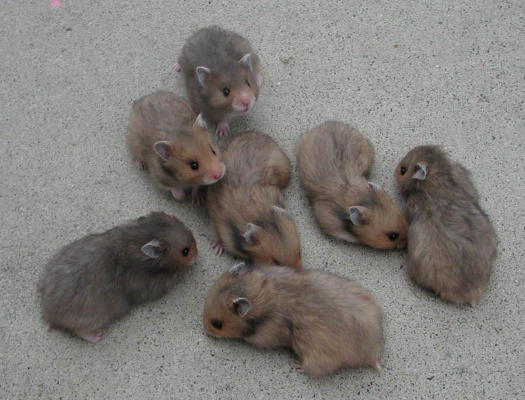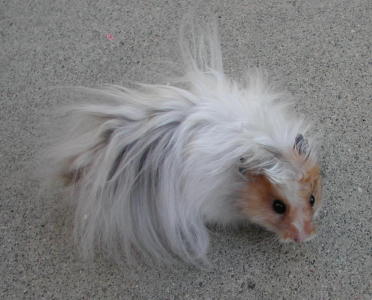
The goal of breeding is always to improve on the parents. Each animal should be carefully analyzed to determine its strengths and weaknesses. Breeding should take place when a good match can be made which improves on the strengths of the parents without accentuating their weaknesses.
Each time I bring a new hamster into my hamstery, I have distinct plans and goals for him/her. Otherwise, there's no reason to introduce new animals. On April 15, 2003, I received a number of new hamsters from The River Road Hamstery. One of these hamsters is Tache, a Recessive Dappled Syrian. This is a gene which I don't currently have in my hamstery (click here for more info on animals received). I need a set of breeding plans to optimize the additions that he offers. This article gives a summary of the process I went through to define and start implementing my plans for Tache.
I am searching for a breeding mate for Tache. He is one of the few Recessive Dappled (RD) Syrians known to be in North America. Thus, there are multiple goals for his line ranging from long-term to short-term goals.
Long-term Goals: Establish the Recessive Dappled gene in our show lines in Southern California, make them available to those in other regions, and eventually create a standard for this gene.
Medium-term Goals: Breed multiple Recessive Dappleds in the near future -- preferably by the end of 2003. These hamsters can then be used toward our long-term goals. Although I have three RD hamsters, Tache is easily the strongest candidate for breeding. He is already over one year old, and he will not live forever. I want to optimize his breeding to create a line of RDs who are better than him and do it before he is retired.
Sub Goal 1: Personally, I would like to breed a Black RD female much like the female I left in Belarus.
Short-term Goals for this litter: Save one to three good females who have no distinct weaknesses as far as show qualities, temperament, etc. are concerned.
Sub Goal 1: I have a strong preference for non-satin females. Since I will be mating them back to their father and he is satin, I don't want the responsibility of keeping all double satin pups.
Sub Goal 2: I have a preference for black females. This will further my medium term goal of creating a high-quality Black Recessive Dappled female since a Black female will double my chances for a Black RD female in the next generation of breeding.
Let’s evaluate Tache and then discuss the females I mated him to.
Tache has a number of strengths and weaknesses.
Strengths
He has good hair length, and it is far more even than the average long-haired male here in our area.
He has good body length.
He has good temperament.
Weaknesses
He lacks fur density.
He is a bit lean in his build. This is most noticeable in his head. You can see that the width between his ears is less than it should be. His body is also lean. We'd like his pups to be more cobby and stocky.
Thus, we'll look for a mate who has a stronger build and good fur density without giving up much in the other areas. Although his markings accentuate his head length, I would definitely like to improve on his head and body structure -- his type. Increasing fur density will take time and many matings, but it's never too early to start.
I'm looking for female pups, and I'd like multiple choices. Since I only want females from this mating, I'm dealing with about half the litter. Then, I have a strong preference for a non-satin female. That whittles my choices in half again. I prefer a black female. That whittles my choices another 50%. Since I won't keep a Dominant Spot daughter from this mating, using a Dominant Spot mother would again whittle my choices in half. I'll be lucky to even get one who meets all of my goals for this litter.
Now why don't I want to keep a Dominant Spot daughter to breed back to her father? The Recessive Dappled gene should be kept free of other pattern genes. At this point, we are still establishing this gene. Mixing it with other pattern genes will dramatically hinder this process. Since the Dominant Spot gene is dominant and the Recessive Dappled gene is recessive, I could do such a mating knowing that I could identify and not keep the Dominant Spot pups from the first mating. (This of course is only possible since I know that none of my current hamsters carries this gene. This assumption will not necessarily be valid in the future if you don't have a complete and detailed pedigree.) Doing this reduces the chances of getting what I want by 50% however.
An additional issue to consider is that I will place some of these pups with club members or other breeders. I will not want to place any of the Dominant Spot pups with these people since I know they will carry the Recessive Dappled gene, and I do not want the two pattern genes mixed in our show animals. I know they will be mixed in the pet store hamsters with time. We can ensure that this doesn't happen in our show lines, though, through careful breeding and pedigrees.
So I may at some time breed Tache to my Dominant Spot females. If I don't get what I want out of these matings, this would be a viable option. I'd rather try initially with non-DS females, however.
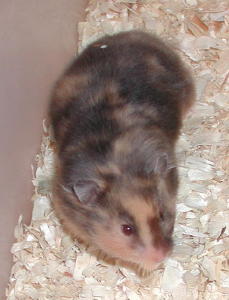
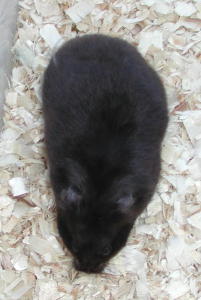
I chose a Black and a Black Tortoiseshell as the first females to mate to Tache. They were mated on April 18th and April 22nd. The litters should be close enough in age that I can evaluate the female pups in the two litters and find one to three daughters to keep and breed back to Tache a few months later. Neither female has any known health problems in her line.
How did I choose these two?
I think Poppy is the better match. I had preferred not to add the Yellow gene into the mix, but Poppy is too good a match not to use her for this mating. She has some of the strengths needed in a mate for Tache. She has a strong build and a reasonably good head structure. Her fur density is very good. Her father (Mr. Nibbles) had very good hair density throughout his length, but he did not have nearly the length that Tache has. Poppy has very good temperament and quite a lot of personality. She is a good overall animal.
Lilly is not as strong a match. As you can see (even though the picture is not very good), her head is a bit weak. It's a bit small compared to her body, and her head is not as broad as we'd like. Since the head structure is also weak on Tache, we may not be able to improve on this characteristic. She does have good fur density and comes from a good line of show winners. Hopefully some of the strength of her line will carry through to her pups.
If there are not enough good choices in these two litters, further matings will take place with other females as they become available for mating.
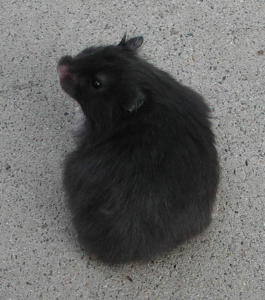
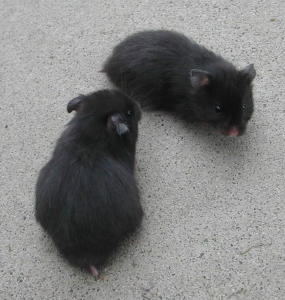
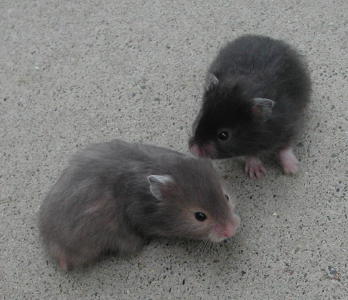
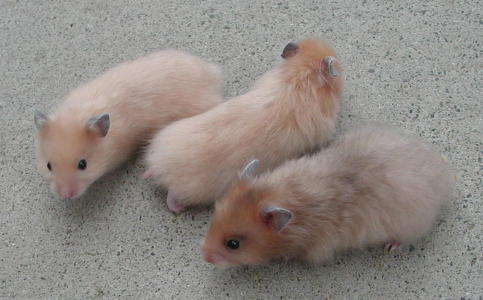
The blacks include a black male and a black satin female. The sables include two males, one of which is satin.
The three to the left are probably a yellow black and two yellow blacks carrying cream. All three are male, and all are satin.
The goldens contain most of the females. Five are female. You can see how dark some of them are. They are umbrous, and none are satin.
